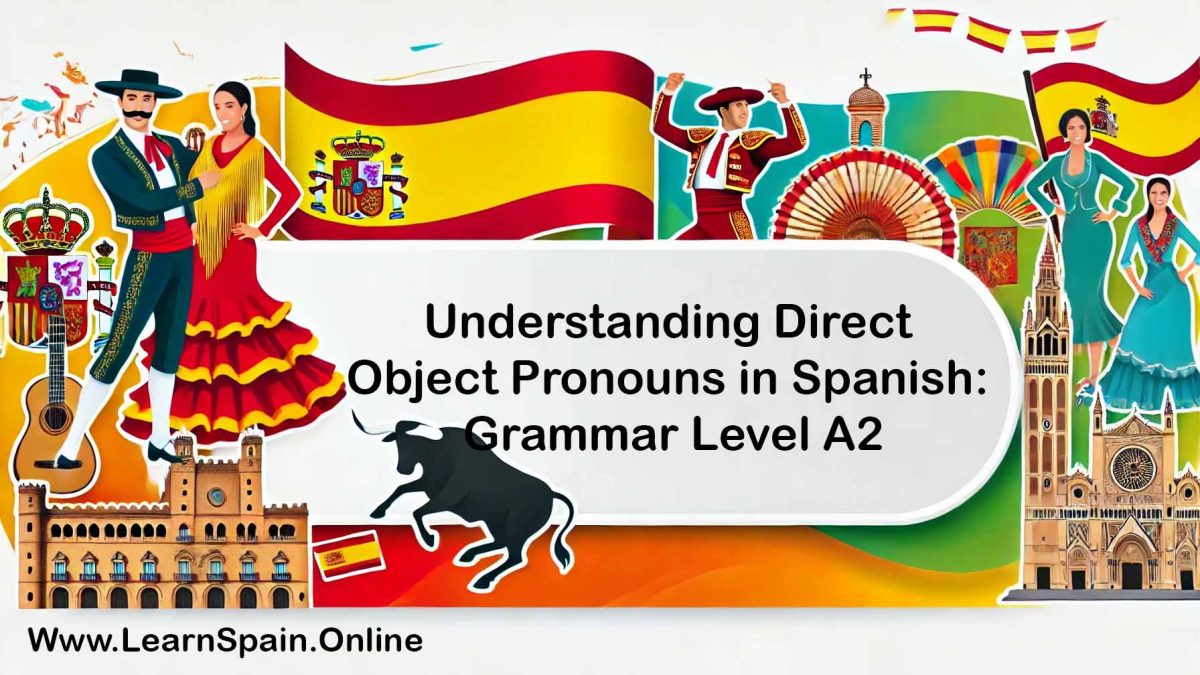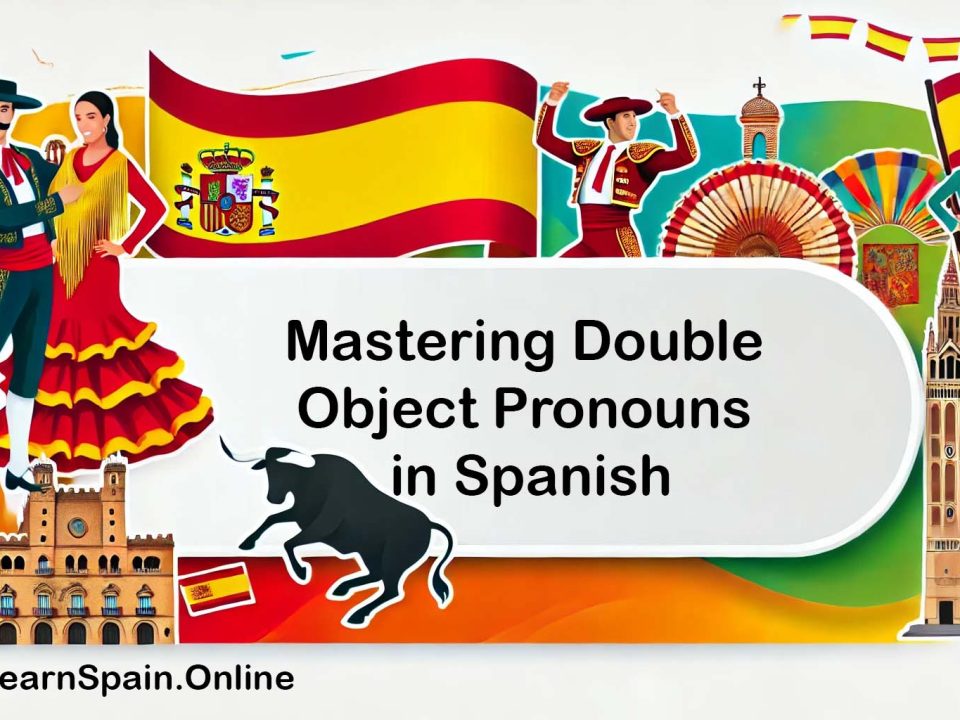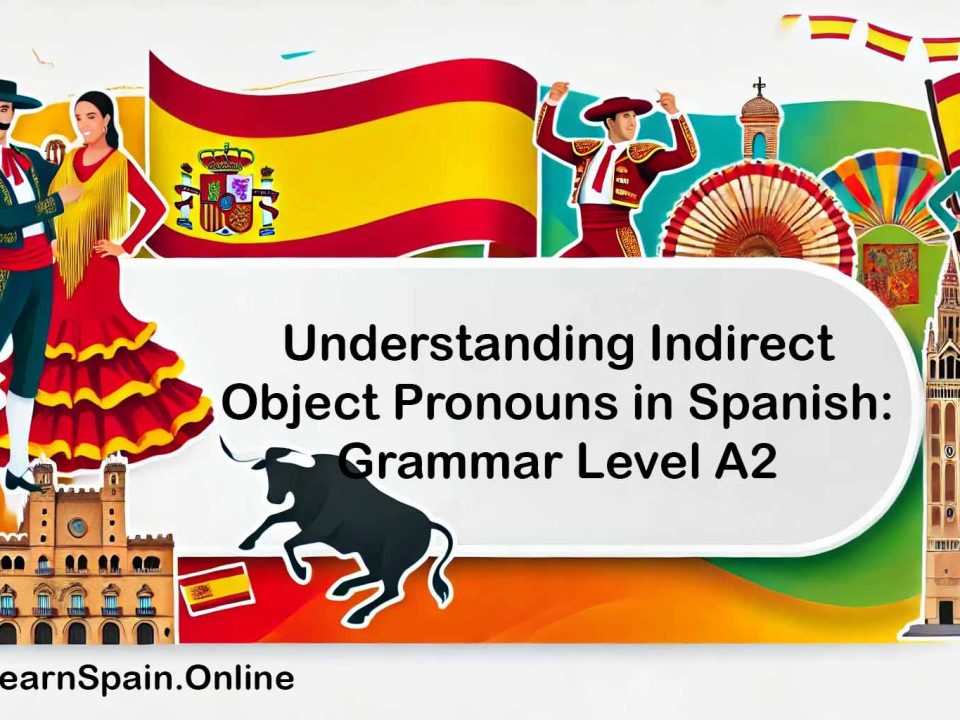
Simple Future vs Immediate Future (Ir a + Infinitive) in Spanish: Grammar Level A2
August 26, 2024
Understanding Indirect Object Pronouns in Spanish: Grammar Level A2
August 26, 2024Understanding Direct Object Pronouns in Spanish: Grammar Level A2
Direct object pronouns are a crucial part of Spanish grammar that can significantly improve the flow and efficiency of your sentences. They allow you to avoid repetition by replacing direct objects with pronouns, making your speech and writing more fluid. In this article, we will explore the concept of direct object pronouns, their uses, and provide plenty of examples to help you master this important aspect of Spanish grammar.
What Are Direct Object Pronouns?
A direct object is the noun that directly receives the action of a verb in a sentence. In other words, it’s the “what” or “whom” that is affected by the verb. In Spanish, as in English, direct object pronouns replace these nouns to avoid redundancy.
For example:
- English: I see the car. -> I see it.
- Spanish: Veo el coche. -> Lo veo.
Direct object pronouns in Spanish are:
- me (me)
- te (you, informal)
- lo (him, it, you formal – masculine)
- la (her, it, you formal – feminine)
- nos (us)
- os (you all, informal in Spain)
- los (them, you all formal – masculine)
- las (them, you all formal – feminine)
Placement of Direct Object Pronouns
In Spanish, direct object pronouns are generally placed before the conjugated verb. However, there are a few variations depending on the verb structure:
1. With a Single Conjugated Verb
When there is a single conjugated verb in the sentence, the direct object pronoun is placed directly before it.
Examples:
- ¿Me ves? (Do you see me?)
- No lo entiendo. (I don’t understand it.)
- Ella te llama. (She calls you.)
- Nos invitan a la fiesta. (They invite us to the party.)
- Los conozco. (I know them.)
2. With a Verb in the Infinitive Form
When there is an infinitive verb in the sentence, the direct object pronoun can either be placed before the conjugated verb or attached to the end of the infinitive.
Examples:
- Voy a comprarlo. (I am going to buy it.)
- Lo voy a comprar. (I am going to buy it.)
- Quiero verte. (I want to see you.)
- Te quiero ver. (I want to see you.)
3. With the Present Progressive (Gerund)
In sentences with the present progressive (estar + gerund), the direct object pronoun can either be placed before the conjugated form of “estar” or attached to the end of the gerund.
Examples:
- Estoy comiéndolo. (I am eating it.)
- Lo estoy comiendo. (I am eating it.)
- Ella está llamándome. (She is calling me.)
- Me está llamando. (She is calling me.)
4. With Affirmative Commands
In affirmative commands, the direct object pronoun is attached directly to the end of the verb.
Examples:
- Cómelo. (Eat it.)
- Hazlo. (Do it.)
- Dime. (Tell me.)
- Tráelos. (Bring them.)
5. With Negative Commands
In negative commands, the direct object pronoun is placed before the verb and after the word “no.”
Examples:
- No lo comas. (Don’t eat it.)
- No lo hagas. (Don’t do it.)
- No me digas. (Don’t tell me.)
- No los traigas. (Don’t bring them.)
Gender and Number Agreement
In Spanish, direct object pronouns must agree in gender and number with the nouns they replace. This is especially important when the direct object pronouns “lo,” “la,” “los,” and “las” are used.
Examples:
- El libro -> Lo leo. (I read it.)
- La revista -> La leo. (I read it.)
- Los libros -> Los leo. (I read them.)
- Las revistas -> Las leo. (I read them.)
Common Uses and Examples
Let’s look at more examples in different contexts to help solidify your understanding of direct object pronouns in Spanish.
1. Basic Sentences
Examples:
- Veo a Juan. -> Lo veo. (I see Juan. -> I see him.)
- Tengo las llaves. -> Las tengo. (I have the keys. -> I have them.)
- Compramos el coche. -> Lo compramos. (We bought the car. -> We bought it.)
2. Questions
Examples:
- ¿Dónde están los libros? -> ¿Dónde están? (Where are the books? -> Where are they?)
- ¿Viste a María? -> ¿La viste? (Did you see María? -> Did you see her?)
- ¿Vas a invitar a tus amigos? -> ¿Los vas a invitar? or ¿Vas a invitarlos? (Are you going to invite your friends? -> Are you going to invite them?)
3. Negative Sentences
Examples:
- No encuentro el dinero. -> No lo encuentro. (I can’t find the money. -> I can’t find it.)
- No llamé a Pedro. -> No lo llamé. (I didn’t call Pedro. -> I didn’t call him.)
- No vamos a ver la película. -> No la vamos a ver. or No vamos a verla. (We are not going to watch the movie. -> We are not going to watch it.)
4. Using Direct Object Pronouns with Infinitives
Examples:
- Quiero leer el libro. -> Lo quiero leer. or Quiero leerlo. (I want to read the book. -> I want to read it.)
- Necesito hacer la tarea. -> La necesito hacer. or Necesito hacerla. (I need to do the homework. -> I need to do it.)
- Voy a vender mi coche. -> Lo voy a vender. or Voy a venderlo. (I am going to sell my car. -> I am going to sell it.)
5. Using Direct Object Pronouns with Gerunds
Examples:
- Estoy escribiendo la carta. -> La estoy escribiendo. or Estoy escribiéndola. (I am writing the letter. -> I am writing it.)
- Estamos cocinando la cena. -> La estamos cocinando. or Estamos cocinándola. (We are cooking dinner. -> We are cooking it.)
- Están viendo la televisión. -> La están viendo. or Están viéndola. (They are watching television. -> They are watching it.)
6. Using Direct Object Pronouns with Commands
Examples:
- Haz la tarea. -> Hazla. (Do the homework. -> Do it.)
- Llama a tu madre. -> Llamala. (Call your mother. -> Call her.)
- Compra los boletos. -> Cómpralos. (Buy the tickets. -> Buy them.)
7. Using Direct Object Pronouns with Negative Commands
Examples:
- No compres el coche. -> No lo compres. (Don’t buy the car. -> Don’t buy it.)
- No digas la verdad. -> No la digas. (Don’t tell the truth. -> Don’t tell it.)
- No tomes las llaves. -> No las tomes. (Don’t take the keys. -> Don’t take them.)
Special Considerations
1. Double Object Pronouns
In some sentences, both a direct and an indirect object pronoun are used. When this happens, the indirect object pronoun always comes first.
Example:
- Le di el libro a María. -> Se lo di. (I gave the book to María. -> I gave it to her.)
In this case, “le” changes to “se” when combined with “lo.”
2. Redundancy for Emphasis
In some Spanish dialects, especially in Latin America, it’s common to use both the direct object noun and the direct object pronoun together for emphasis or clarity.
Example:
- La casa la pinté yo. (The house, I painted it.)
- El libro lo compré ayer. (The book, I bought it yesterday.)
Practice Exercises
To reinforce your understanding of direct object pronouns, try the following exercises:
Translate the Sentences:
- I see the cat. -> Lo veo.
- We are eating the apples. -> Las estamos comiendo. or Estamos comiéndolas.
- She is writing a letter. -> Ella la está escribiendo. or Ella está escribiéndola.
- **
They will buy the tickets.** -> Los comprarán.
- Do the homework! -> ¡Hazla!
Complete the Sentences:
- Quiero leer el libro. -> Quiero leer__. (I want to read it.)
- Ella no encontró las llaves. -> Ella no _ encontró. (She didn’t find them.)
- Vamos a llamar a Juan. -> Vamos a llamar_____. (We are going to call him.)
- No quiero comer la pizza. -> No quiero comer_____. (I don’t want to eat it.)
- ¿Viste la película? -> ¿_ viste? (Did you see it?)
Correct the Sentences:
- Voy a verlo la película.
- Voy a ver la película.
- La voy a ver.
- Voy a verla.
- No lo laves los platos.
- No los laves.
- Está escribiéndola la carta.
- Está escribiéndola.
- La está escribiendo.
- Compré las.
- Las compré.
- Dámelo el libro.
- Dámelo.
Conclusion
Mastering direct object pronouns in Spanish is essential for fluency and effective communication. These pronouns help streamline sentences, avoid redundancy, and make conversations more natural. By understanding how to use and place direct object pronouns correctly, you will enhance your ability to speak and write in Spanish with greater confidence. Practice regularly, and soon, using direct object pronouns will become second nature. ¡Buena suerte! (Good luck!)
Links:
Spanish Grammar
Spanish Vocabulary
Spanish Listening
Spanish Stories



